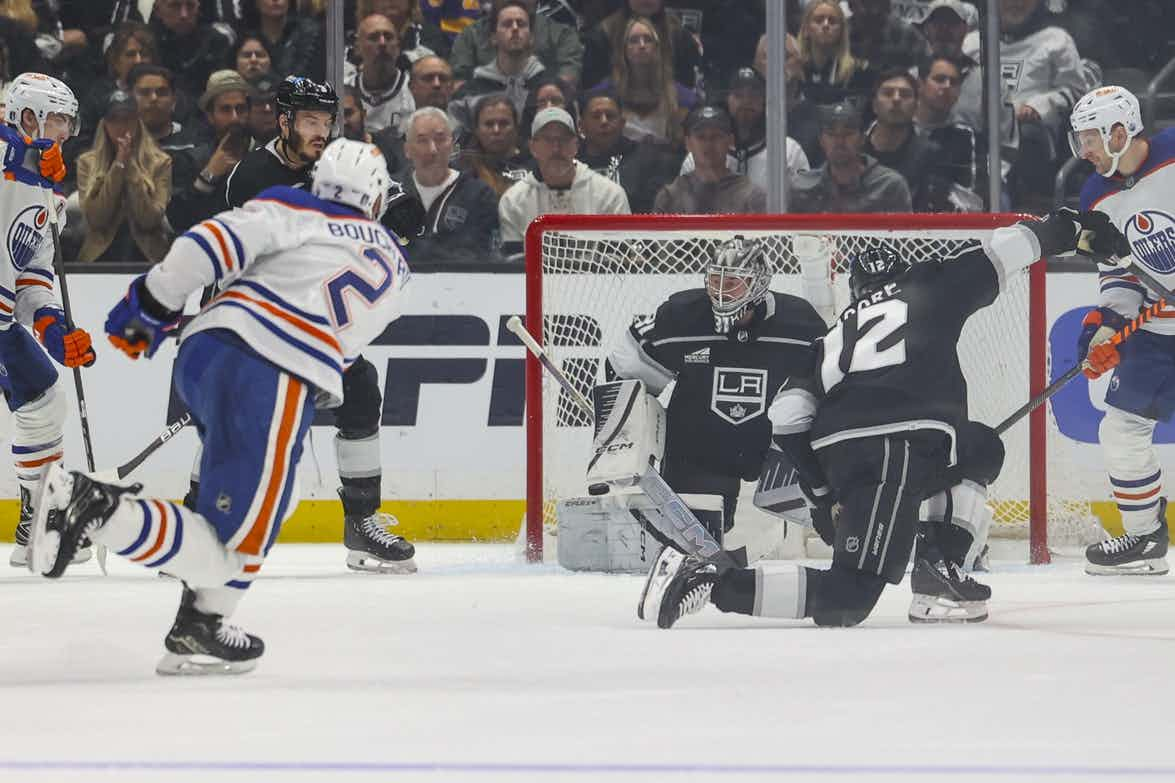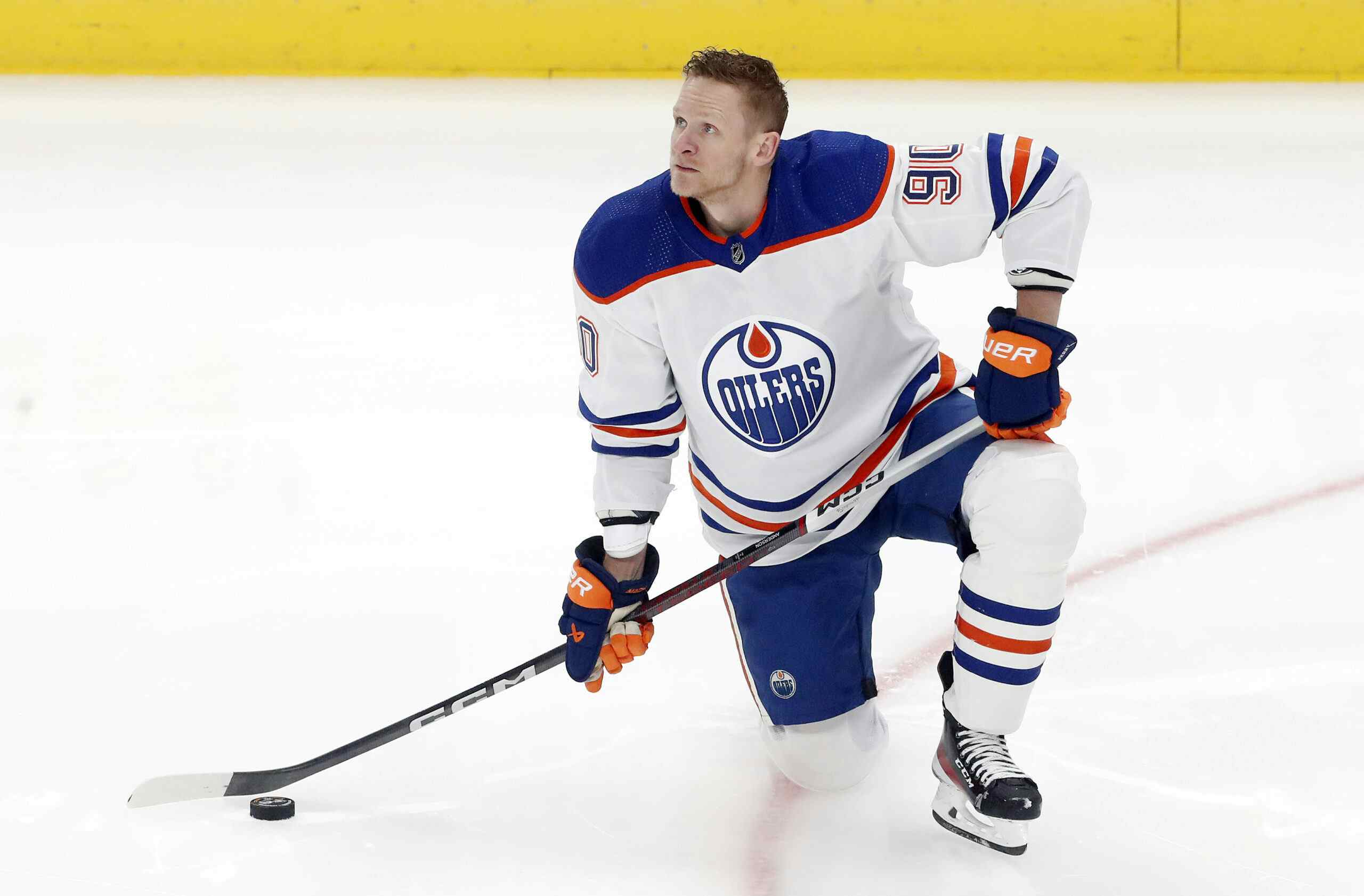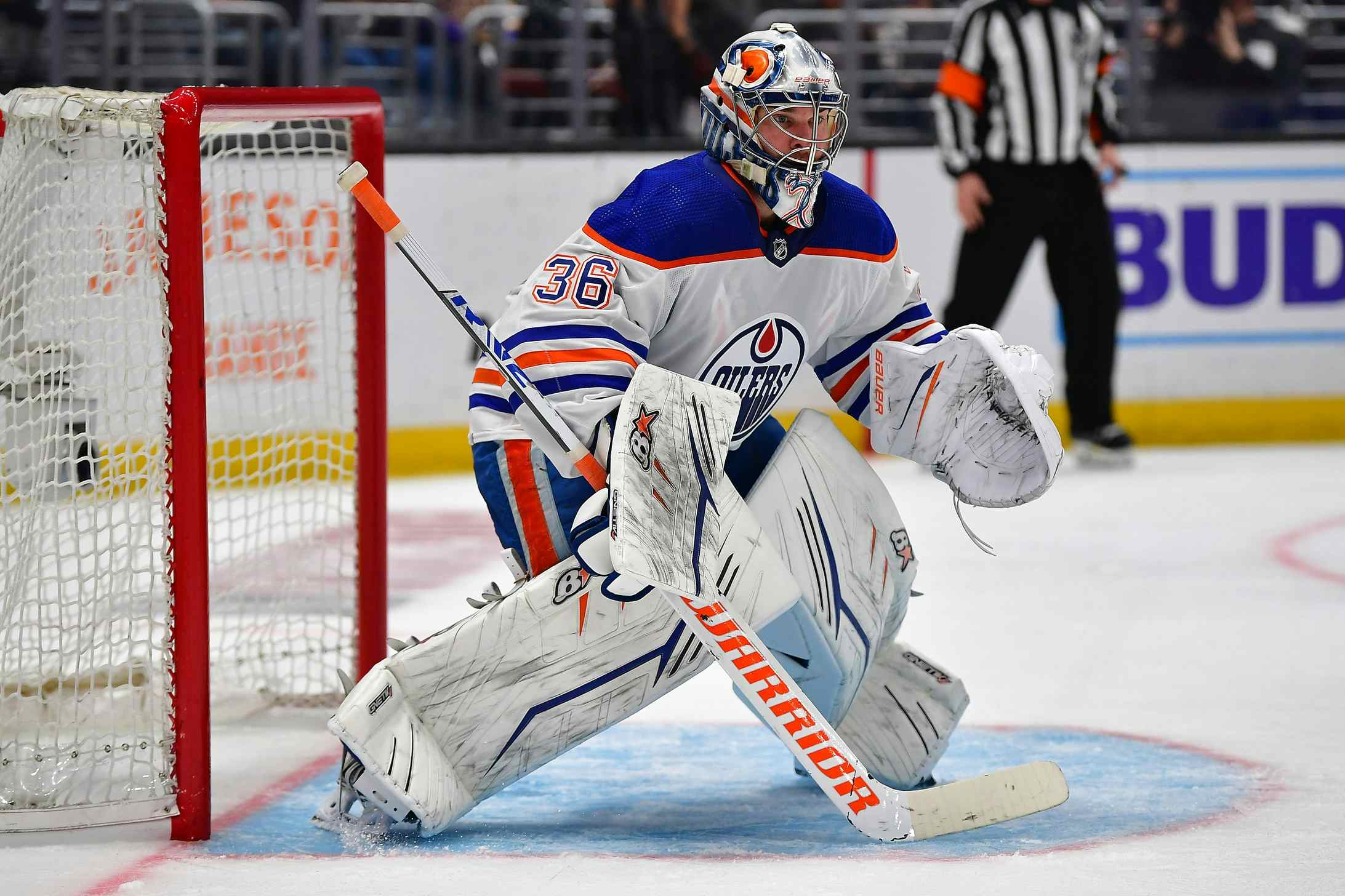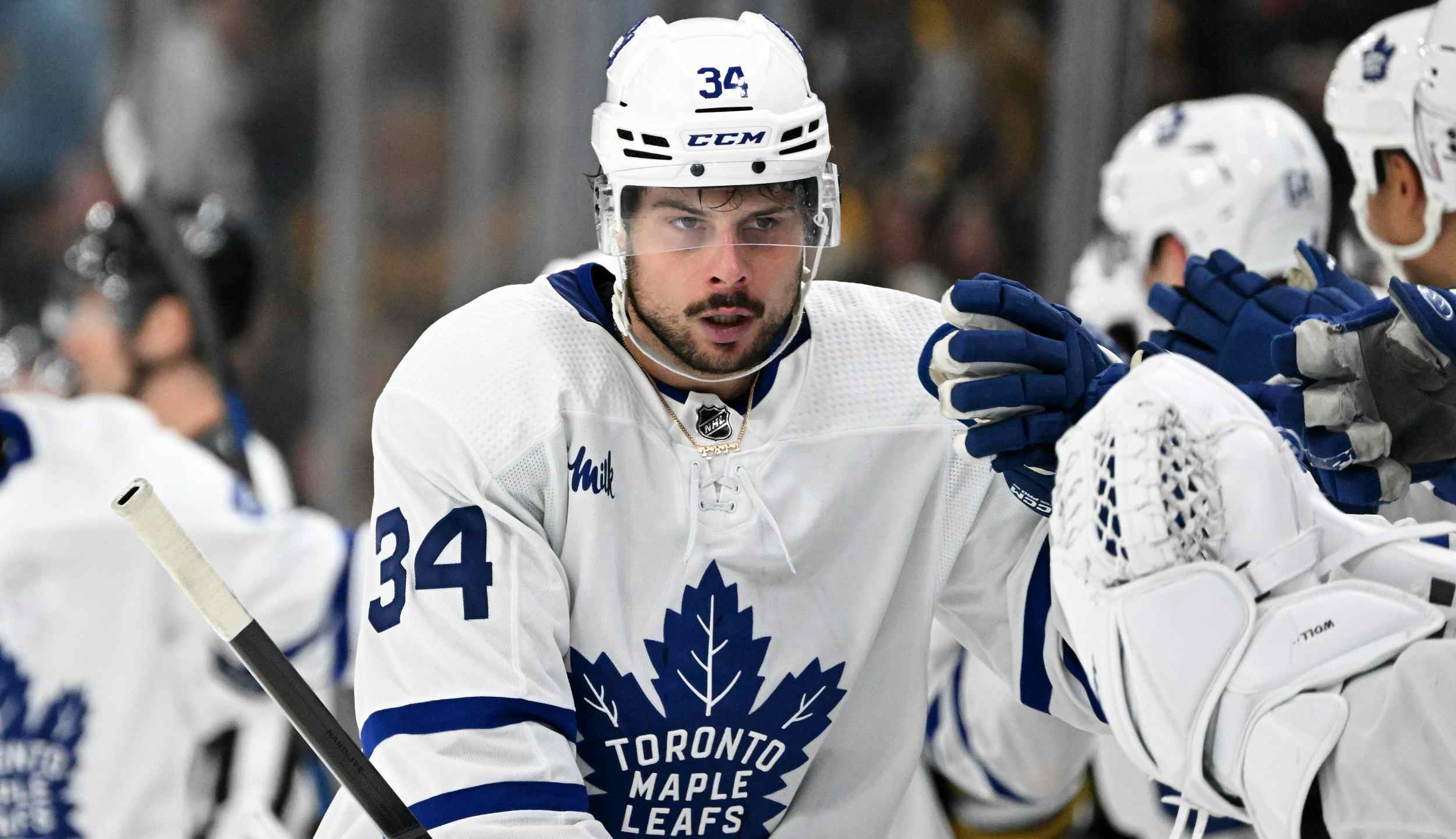The 2014-15 Edmonton Oilers Powerplay

Edmonton’s offseason changes have been discussed with a fair degree of thoroughness, but one thing I haven’t seen covered is the makeup of the power play. Four regulars (five counting Ales Hemsky) from last year’s unit have since departed, and a number of the team’s recent additions could figure in as replacements. All that, and we haven’t even mentioned the impact of new assistant coach Craig Ramsay on the unit.
So, how should the coaching staff run this year’s unit?
The Forwards

Players ranked by average minutes per game on the power play in 2013-14.
- Taylor Hall (LH). Hall’s averaged about 3:00 per game at five-on-four over the last few seasons for the Oilers. His point totals and on-ice goal totals are excellent (he’s 11th among NHL forwards in points/hour 5-on-4 over the last three seasons), he can both shoot and pass, and the unit’s on-ice shot numbers have steadily improved with him out there. He’s a lock for the first unit.
- Jordan Eberle (RH). Eberle’s a touch back of Hall in virtually every individual category, and unsurprisingly he’s on the same level in terms of on-ice numbers. His 5-on-4 points per hour figure (4.45) over the last three seasons ranks 41st in the NHL and he tied for the team lead with 20 points on the power play in 2013-14. He’s another certain first unit forward.
- Teddy Purcell (RH). Purcell has more bad seasons than good on the power play, and the best way to sum up his scoring totals (3.78 points/hour) over the last three seasons is probably to say that they’re in the same range as those posted by Sam Gagner (3.73 points/hour). As in all things he’s more playmaker than goal-scorer.
- Ryan Nugent-Hopkins (LH). The top five playmakers (in terms of assists per hour) in 5-on-4 situations over Nugent-Hopkins career are as follow: Nicklas Backstrom, Claude Giroux, Nugent-Hopkins, Sidney Crosby and Evgeni Malkin. We’ve looked at him before; there’s a strong case that he’s the machine that makes the whole unit work.
- David Perron (RH). Perron’s eight power play goals last season were a career high; he’d previously never topped five. He’s been a perfectly mediocre power play scorer over his career and for the most part the power play units he’s been a part of haven’t scored at a particularly noteworthy rate.
- Nail Yakupov (LH). It’s pretty early to judge one way or the other on Yakupov, at least by the numbers; he’s played roughly four hours of five-on-four total over his NHL career. He looked awfully good as a goal-scorer in 2012-13 and every time I see him shoot I think he has a future as the primary triggerman on a power play unit.
- Benoit Pouliot (LH). Pouliot scored seven power play goals last season, which pretty much doubled his career totals (he’d had eight over the entirety of his major league career entering 2013-14). There is one potential big point in his favour, though: he’s pretty much always played second unit minutes, which dramatically reduces opportunity. The flip side of that is no coach has ever seen enough to stick him on the top unit long term.
- Mark Arcobello (RH). The NHL numbers are pretty useless when it comes to judging Arcobello’s power play production, because the sample is so limited. He doesn’t have much of a shot but he’s special as a playmaker.
- Anton Lander (LH). Lander looked out of place on an NHL power play during his late-season stint in Edmonton, but he did score 10 goals in 46 AHL games while on the man advantage and has a surprisingly heavy and accurate shot (at least, surprising for anyone who has seen his tentative offensive gamei n the majors).
- Leon Draisaitl (LH). A total wildcard. Draisaitl ran up crooked numbers on the power play last season; among first-time CHL draft eligibles only Sam Reinhart collected more points on special teams.
The Defencemen

As before, players ranked by average minutes per game on the power play in 2013-14.
- Justin Schultz (RH). Schultz could be a good fit based on history; he was glorious in Oklahoma City and carried it over in a major way to an NHL power play in 2012-13 (seriously, he was over 5.0 points per hour, which is Shea Weber territory). Everything went wrong in 2013-14; his numbers were miserable and the eye test said he couldn’t hold the puck in on the point or break glass with his slapshot.
- Jeff Petry (RH). Petry had a nice power play season in 2011-12, but overall the numbers aren’t kind to him; of the 115 defencemen to play at least 200 minutes at five-on-four over his four year career Petry ranks 104th in scoring.
- Nikita Nikitin (LH). Nikitin had two strong scoring years on the power play to start his career, then dipped a little in 2012-13 and was all-but-dumped in 2013-14. He has a heavy shot and can make a pass; one wonders whether he doesn’t deserve a more prolonged shot.
- Martin Marincin (LH). Marincin has a hard shot and a track record of pretty solid numbers at other levels, but he’s played all of 20 minutes on the power play in the majors.
- Andrew Ference (LH). It’s easy to forget these days, but Ference was an awfully good scoring defenceman in the WHL and AHL and has had some pretty decent power play years in the majors; he’s gone basically unused over the last five seasons.
- Oscar Klefbom (LH). Someone was going to suggest it. He hasn’t scored at any level in ages, though.
- Darnell Nurse (LH). He’s been pretty good in junior, scoring six goals on the power play last season, but again he’s a total wildcard.
Configuration

The Oilers’ most proven power play options are the trio of players who make up the top line: Nugent-Hopkins, Hall and Eberle. Assuming the team doesn’t want to revisit the five forward power play (though Oklahoma executed it nicely at times last season and Barons coach Todd Nelson told me he’s used it successfully in years prior) Edmonton’s best defence option is probably Justin Schultz.
Given those four players, the idea of a basic 1-3-1 setup is pretty obvious. Hall’s done nice work in the slot, Eberle and Nugent-Hopkins fit the quarterback description on either side of him, and the formation depends more on getting pucks on net rather than a hard point shot, which fits Schultz’s skillset. The power play can shift to a different look pretty easily, too; with Hall and Pouliot on either side of the net it’s an umbrella, and Hall can slide down into the corner to turn it into an overload play.
The obvious problem is a lack of a consistently heavy shot from either the point or the half-boards, which is probably why the Oilers are so focused on the down-low play. If the group isn’t working early, they might try plugging Nikitin or Yakupov in for Schultz – if a defenceman is needed in the latter case, Schultz could always take Eberle’s slot on the half-boards too.
That second unit has pretty decent options, too.
Nikitin seems the obvious candidate for the point position; he’s likely to be on the same even-strength pair as Schultz and he has a reputation for a heavy shot. The other obvious placement is Yakupov in on the half-boards; he’s a reasonably good playmaker and that’s the best place for his one-timer.
The other three choices are less clear, in part because we don’t really know what’s going to happen at centre. Both Perron and Purcell seem like locks, and the final slot could go to any of Draisaitl, Arcobello, Lander or the newcomer; I’ve assumed Draisaitl. Purcell seems a good fit for the half-boards, and I’ve slotted the last two players with the idea of both mirroring the top unit but on the other side of the ice and limiting Draisaitl’s responsibilities.
As with the first unit, the second becomes an umbrella pretty easily with Perron and Draisaitl on opposite sides of the net; more importantly (because I’d really want Yakupov on the weak side) it can shift to an overload play with either Perron moving down to the corner or Purcell cycling down and Perron taking his spot.
The Oilers have a lot of talent at their disposal, but Schultz seems the critical link. If he can generate the kind of results he did on the point in 2012-13 (either in the AHL or the NHL) the Oilers will be in great shape; if not changes will need to be made.
Note: NHL.com incorrectly lists Pouliot as a right-handed shot, and I forgot to check. Given that, it might make more sense to swap Perron to the net front role on the first power play and slide Pouliot into his spot on the second unit. It also makes the idea of sticking Purcell in front of the net and putting Arcobello on the half-boards a little more appealing.
RECENTLY BY JONATHAN WILLIS
Recent articles from Jonathan Willis





